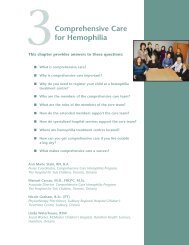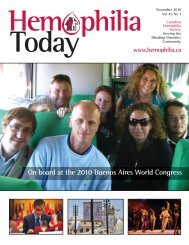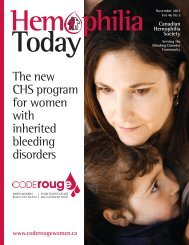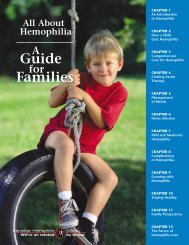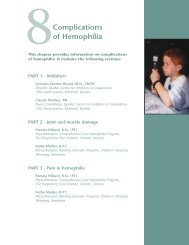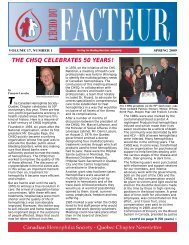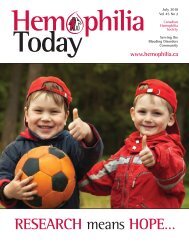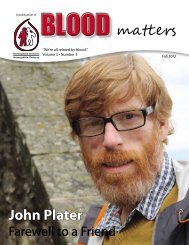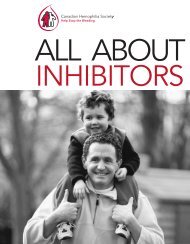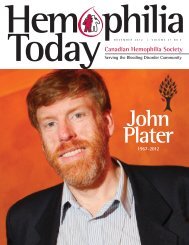Canadian Hemophilia Society Meeting the challenge
Canadian Hemophilia Society Meeting the challenge
Canadian Hemophilia Society Meeting the challenge
- No tags were found...
Create successful ePaper yourself
Turn your PDF publications into a flip-book with our unique Google optimized e-Paper software.
<strong>Canadian</strong> <strong>Hemophilia</strong> <strong>Society</strong><strong>Meeting</strong> <strong>the</strong> <strong>challenge</strong>2011 annual report
NATIONAL OFFICE400-1255 University StreetMontreal, Quebec H3B 3B6Tel.: 514-848-0503Toll-free: 1-800-668-2686Fax: 514-848-9661E-mail: chs@hemophilia.caPROVINCIAL OFFICESMANITOBA CHAPTER944 Portage AvenueWinnipeg, Manitoba R3G 0R1Tel.: 204-775-8625Toll-free: 1-866-775-8625E-mail: chsmb@hemophilia.mb.caNATIONAL STAFFDavid PageNational Executive DirectorJoyce ArgallNatonal Individual Giving ManagerHélène BourgaizeNational Director of Chapter Relations andHuman ResourcesClare CecchiniNational Program ManagerDeborah Franz CurrieNational Director of Resource Development<strong>Canadian</strong> <strong>Hemophilia</strong> <strong>Society</strong>HEMOPHILIA ONTARIO501-65 Wellesley Street EToronto, Ontario M4Y 1G7Tel.: 416-972-0641Toll-free: 1-888-838-8846Fax: 416-972-0307E-mail: hemont@hemophilia.on.caQUEBEC CHAPTER1102-2120 Sherbrooke St. E.Montreal, Quebec H2K 1C3Tel.: 514-848-0666Toll-free: 1-877-870-0666Fax: 514-904-2253E-mail: info@schq.orgStéphane LemieuxChief AccountantRachel LeslieNational Executive AssistantMichel LongNational Program ManagerChantal RaymondNational Communications Manager2To contact our 7 o<strong>the</strong>r provincial chapters, visit us at www.hemophilia.ca.
our missionThe <strong>Canadian</strong> <strong>Hemophilia</strong><strong>Society</strong> is committed toimprove <strong>the</strong> health and qualityof life of all people withinherited bleeding disordersand ultimately to find a cure.our visionA world free from <strong>the</strong> painand suffering of inheritedbleeding disorders.2011 Annual Report3
Craig UpshawPresidentDavid PageNational Executive DirectorNew <strong>challenge</strong>s… new opportunities<strong>Canadian</strong> <strong>Hemophilia</strong> <strong>Society</strong>THIS ANNUAL REPORT focuses on <strong>the</strong> <strong>Canadian</strong> <strong>Hemophilia</strong> <strong>Society</strong>’s achievements in 2011, <strong>the</strong> first yearof our five-year strategic plan… and <strong>the</strong>y are considerable. A top-notch medical and scientific meeting inCalgary. An ever-more active research program with record levels of support to <strong>Canadian</strong> researchers. Highqualityeducation programs for people with bleeding disorders. Strong support for <strong>the</strong> health care providers inCanada’s 25 comprehensive care clinics. At <strong>the</strong> same time, we have worked to maintain access to an optimal supply ofclotting factor concentrates at no cost to <strong>the</strong> end user.However, we must already look to <strong>the</strong> future where <strong>the</strong>re are new <strong>challenge</strong>s and, hopefully, newopportunities.Since <strong>the</strong> introduction of factor concentrates in <strong>the</strong> late 1960s, we have seen some important changes,including major advances in safety, but none of <strong>the</strong>se changes significantly altered how well <strong>the</strong> productsworked. This is about to change. In <strong>the</strong> not-so-distant future, perhaps in 2014, <strong>the</strong> first longer half-life products willbe approved for use. For some, this could mean a reduction in <strong>the</strong> frequency of treatments required for prophylaxis.For o<strong>the</strong>rs, <strong>the</strong>se products could mean higher “trough” levels and better protection against bleeds (a trough is <strong>the</strong>lowest factor level between doses of prophylaxis). And <strong>the</strong>re has even been a breakthrough in gene <strong>the</strong>rapy, bringing<strong>the</strong> hope of a cure. Indeed, <strong>the</strong>se changes point to an exciting future, but <strong>the</strong>re are also storm clouds on <strong>the</strong> horizon.For <strong>the</strong> last 25 years, <strong>the</strong> CHS has successfully advocated for physician/patient choice and access to <strong>the</strong> mostadvanced treatment products. Doing so will be even more critical when <strong>the</strong> next generation of products hits <strong>the</strong>market. With <strong>the</strong> current health funding <strong>challenge</strong>s, we are already hearing questions around <strong>the</strong> cost of factorconcentrates, monitoring of product utilization and <strong>the</strong> merit (or lack of merit) of prophylaxis care for adults. We areseeing <strong>the</strong> emergence of evidence-based medicine and <strong>the</strong> need to show positive outcomes to justify all <strong>the</strong> dollarsinvested. The importance of documenting utilization of expensive factor concentrates has never been greater.Documenting product use with modern tools and linking it to health outcomes will be crucial to maintaining ouraccess to an optimal supply of <strong>the</strong> safest, most efficacious products.4
More than ever, our national organization needs to stay abreast of safety and supply issues. Ourchapters must be informed, proactive and able to advocate on behalf of people with bleeding disorders andour bleeding disorder treatment centres. Access to <strong>the</strong> most advanced <strong>the</strong>rapies at no cost to <strong>the</strong> end user,delivered by well-resourced clinics, will be <strong>the</strong> key advocacy focus for <strong>the</strong> CHS in coming years.Ano<strong>the</strong>r <strong>challenge</strong> is under-diagnosis. There may be 30,000 <strong>Canadian</strong>s with symptoms of bleeding disordersserious enough to require specialized care, yet only 8,500 are registered in Canada’s comprehensive carecentres. In 2011, <strong>the</strong> CHS developed its CODErouge program to reach out to women with bleeding disorders.The program was officially launched in May 2012. Over <strong>the</strong> next three years, <strong>the</strong> CHS will be working closelywith <strong>the</strong> Association of <strong>Hemophilia</strong> Clinic Directors of Canada and <strong>the</strong> <strong>Society</strong> of Obstetricians andGynaecologists of Canada to raise awareness about bleeding disorders in women, and to improve diagnosisand care.There are <strong>challenge</strong>s within <strong>the</strong> CHS as well. We are re-defining our membership categories to include ourpartners in <strong>the</strong> clinics. We are working more closely with staff in those clinics to make sure that all people withbleeding disorders know of, and can have access to, CHS programs and services. We are reviewing our by-lawsin light of <strong>the</strong> recently adopted Canada Not-for-profit Corporations Act (CNCA). In 2012, in an effort to domore with less, <strong>the</strong> Board of Directors has decided to discontinue most face-to-face committee meetings andone of its two annual board meetings. We are required to work smarter, adopt communication tools such aswebinars and increase <strong>the</strong> frequency of teleconferences. In addition to <strong>the</strong>se changes, <strong>the</strong> CHS will also bemaking a decision to restructure <strong>the</strong> national board, reducing its size almost in half from its current 25directors. The goal of <strong>the</strong> restructuring is not only to reduce expenses but also to enhance directoraccountability, and increase collaboration and board effectiveness.Challenges can be barriers to progress but <strong>the</strong>y can also be opportunities to innovate and grow.We are optimistic for <strong>the</strong> future of <strong>the</strong> organization and our collective ability to advocate for optimalcare and treatment.2011 Annual Report5
Important to know… One in 100 <strong>Canadian</strong>s, men and women,carry an inherited bleeding disorder gene,and more than 35,000 of <strong>the</strong>m havesymptoms severe enough to requiremedical care. Yet many have not beenproperly diagnosed! There are no cures for inherited bleedingdisorders. They are lifelong conditions. Effective treatment is available for thosediagnosed. Left untreated, however,bleeding disorders are life-threatening. Blood products, <strong>the</strong>ir recombinantsubstitutes and o<strong>the</strong>r drugs are effectivein treating people with bleeding disorders,but <strong>the</strong>y are not a cure! The <strong>Canadian</strong> <strong>Hemophilia</strong> <strong>Society</strong> isactive in ensuring <strong>the</strong> safety of <strong>the</strong> bloodsupply in Canada through constantvigilance and monitoring for all<strong>Canadian</strong>s.2011 Annual Report7
Working to meet <strong>the</strong> <strong>challenge</strong>The CHS is committed to offering quality services to individualswith inherited bleeding disorders.THESE SERVICES could not grow, much less exist, without <strong>the</strong> incredible support of ourpartners. From <strong>the</strong> teams of health care professionals at <strong>the</strong> comprehensive care clinics, toour generous partners in <strong>the</strong> pharmaceutical industry, our corporate and individual donors,and our invaluable volunteers-all are responsible for <strong>the</strong> success of our programs and services.With <strong>the</strong>ir support, <strong>the</strong> CHS is able, year after year, to achieve its goals in <strong>the</strong> following fields: Care and treatment Support and education Awareness Research Safe and secure supply<strong>Canadian</strong> <strong>Hemophilia</strong> <strong>Society</strong>8
Care and treatmentCARE AND TREATMENT for people with inherited bleeding disorders requires <strong>the</strong>expertise of a multidisciplinary team of health care professionals: physicians, nurses,physio<strong>the</strong>rapists, social workers and a range of o<strong>the</strong>r specialists such as psychologistsand gynaecologists. For decades now, <strong>the</strong> CHS has worked tirelessly to build anetwork of treatment centres for bleeding disorders serving people in every province.In 2011, to maintain standards of care across <strong>the</strong> countryand to make constant progress in CARE and TREATMENT:▪▪▪We hosted a successful Rendez-vous 2011 – New Challenges, our biennial medicaland scientific symposium which included key sessions on rare inherited bleedingdisorders, mild hemophilia and ageing.We supported annual meetings of <strong>the</strong> physio<strong>the</strong>rapists, nurses and social workersassociated with <strong>the</strong> 25 hemophilia treatment centres across Canada.We continued to promote <strong>the</strong> CHS Transition Toolkit and supported chapters andclinics holding transition orientation events to facilitate a more harmonious shiftfrom guardian-directed care to more autonomous adult care for young peopleand <strong>the</strong>ir families.‘‘One of <strong>the</strong> highlights of Rendez-vous 2011 -New Challenges was <strong>the</strong> panel discussion wherefamilies and individuals related personalexperiences and shared <strong>the</strong>ir stories. With alleyes on <strong>the</strong> panel, wiping away silent tears, weall realized why we work so hard at this job andwalked away with more skills to confront <strong>the</strong>new <strong>challenge</strong>s.– A nurse in hemophilia careDuring <strong>the</strong> afternoon focus group on ageingwith hemophilia/bleeding disorders held duringRendez-vous 2011, I had <strong>the</strong> pleasure andhonour to share in facilitating <strong>the</strong> session. Twoor three passing phrases from participants seemfitting conclusions to this brief discussion andset <strong>the</strong> stage for <strong>the</strong> <strong>challenge</strong>s of <strong>the</strong> next25 years. Several voiced with convictionswrought from years of personal experience,“We are <strong>the</strong> survivors of what is past! We are<strong>the</strong> pioneers of where we came from and wherewe’re going! We are strong in confidence earnedfrom what we have overcome. We are committedto meeting <strong>the</strong> <strong>challenge</strong>s of ageing that liebefore us.”– John R. (Jack) McDonald, Ph.D.’’CHS Honorary Life Member, Calgary2011 Annual ReportA C H I E V E O P T I M A L C O M P R E H E N S I V E C A R E F O R A L L P E O P L E W I T HI N H E R I T E D B L E E D I N G D I S O R D E R S .9
Support and educationThe quality of work of <strong>the</strong> CHS is best represented throughits exceptional publications and life-changing workshops.THE CHS IS VERY PROUD of and has often been recognized internationally for <strong>the</strong> high-quality, upto-date,easy-to-understand educational material it has produced as well as <strong>the</strong> powerful meetingsit has organized that bring toge<strong>the</strong>r people with bleeding disorders, <strong>the</strong>ir families and health careprofessionals.In 2011, <strong>the</strong> CHS again impressed with its work in EDUCATIONand SUPPORT:<strong>Canadian</strong> <strong>Hemophilia</strong> <strong>Society</strong>Hem philiaMarch 2011Vol 46 No 1<strong>Canadian</strong>Today<strong>Hemophilia</strong><strong>Society</strong>Serving <strong>the</strong>Bleeding DisordersCommunitywww.hemophilia.ca Hem philiaTodayRARE inherited bleeding disordersMILD hemophiliaAugust 2011Vol 46 No 2<strong>Canadian</strong><strong>Hemophilia</strong><strong>Society</strong>Serving <strong>the</strong>Bleeding DisorderCommunitywww.hemophilia.caAGINGLearning and Sharing in Calgaryat Rendez-vous 2011Hem philiaTodayThe newCHSprogramfor womenwithinheritedbleedingdisorderswww.coderougewomen.caNovember 2011Vol 46 No 3<strong>Canadian</strong><strong>Hemophilia</strong><strong>Society</strong>Serving <strong>the</strong>Bleeding DisorderCommunity<strong>Hemophilia</strong> Today November 2011 | 1“We always enjoy reading <strong>Hemophilia</strong> Today. You are doing some great work in Canada!”– The Hemostasis and Thrombosis Center at Children’s Hospital Los Angeles10P R O V I D E E F F E C T I V E D E L I V E R Y O F I N F O R M A T I O N A N D S U P P O R T T O P A T I E N T SA N D T H E I R F A M I L I E S A C R O S S C A N A D A I N B O T H E N G L I S H A N D F R E N C H.
▪▪▪▪▪To keep <strong>the</strong> bleeding disorder community informed, we distributed three issues of our highly informative newsmagazine<strong>Hemophilia</strong> Today.To increase knowledge, networking and peer support among people who suffer from rareinherited bleeding disorders, two Rare Bleeding Disorders Through <strong>the</strong> Lifespan regionalworkshops were held.To increase <strong>the</strong> understanding about <strong>the</strong> impact of ageing on people affected by aninherited bleeding disorder, <strong>the</strong> topic of ageing was addressed at Rendez-vous 2011 during<strong>the</strong> CHS Medical and Scientific Symposium and through a focus group. Also, a new columnon ageing, The Sage Page, now appears in <strong>Hemophilia</strong> Today and a Partners in Care cardwas developed for use with o<strong>the</strong>r specialists such as dentists and general practitioners.To enable parents to increase <strong>the</strong>ir skills and knowledge regarding raising a child with a bleeding disorder, two regionalParents Empowering Parents (PEP) workshops were delivered across Canada.To increase awareness and knowledge among women and health care providers about symptoms, diagnosis andtreatment of bleeding disorders such as von Willebrand disease, we developed a targeted outreach program entitledCODErouge | WHEN WOMEN BLEED TOO MUCH.2011 Annual Report11
AwarenessProper care following an accuratediagnosis is certainly one of <strong>the</strong>CHS' most important goals.TO ACHIEVE OPTIMAL COMPREHENSIVE CARE for all people withinherited bleeding disorders, awareness initiatives need to beundertaken at two levels: <strong>the</strong> health care providers who may comeinto contact with people with inherited bleeding disorders, and <strong>the</strong>general population.In 2011, <strong>the</strong> CHS has worked hardto increase awareness:▪In April, World <strong>Hemophilia</strong> Day was <strong>the</strong> perfect occasion toraise public awareness. Activities were held across <strong>the</strong> countryto reach out and educate people potentially suffering from ableeding disorder.<strong>Canadian</strong> <strong>Hemophilia</strong> <strong>Society</strong>▪▪The new CHS awareness program, CODErouge | WHEN WOMEN BLEED TOO MUCHwas developed to increase awareness and knowledge among women andhealth care providers about symptoms, diagnosis and treatment of bleedingdisorders such as von Willebrand disease.To increase awareness and knowledge among family physicians and gynaecologists about symptoms, diagnosisand treatment of von Willebrand disease (VWD), we participated as exhibitors at <strong>the</strong> Primary Care Conference inToronto and <strong>the</strong> Family Medicine Forum in Montreal targeting approximately 4,000 family physicians.12R A I S E A W A R E N E S S A M O N G P E O P L E W I T H I N H E R I T E D B L E E D I N G D I S O R D E R S,T H E I R I M M E D I A T E C O M M U N I T I E S A N D H E A L T H C A R E P R O V I D E R S.
ResearchCHILDREN WITH HEMOPHILIA rely on research toimprove <strong>the</strong>ir quality of life. It is also true for womensuffering from heavy menstrual bleeding due to aninherited bleeding disorder and for men withhemophilia facing new <strong>challenge</strong>s brought on byageing. They can all count on <strong>the</strong> relentless work ofresearchers to reach new heights in treatment as well asto gain a better understanding of all inherited bleedingdisorders.▪▪The CHS provides clinical and research fellowships andfunds to leading <strong>Canadian</strong> researchers working in <strong>the</strong>field of bleeding disorders.Over <strong>the</strong> past20 years, thanksto <strong>the</strong> <strong>Hemophilia</strong>Research Million DollarClub endowment,generous individualdonors, committedcorporate sponsors andCHS chapters and regions across <strong>the</strong> country, <strong>the</strong> CHShas invested more than four million dollars in research inCanada.RESEARCH means HOPE for thoseaffected by an inherited bleeding disorder.This is why in 2011, <strong>the</strong> CHS funded six research projectsthrough three different research programs:▪▪▪The CHS Dream of a Cure Research ProgramThe Care Until Cure Research Program in collaborationwith PfizerThe CSL Behring – <strong>Canadian</strong> <strong>Hemophilia</strong> <strong>Society</strong> (CHS)– Association of <strong>Hemophilia</strong> Clinic Directors of Canada(AHCDC) Hemostasis Fellowship ProgramDetailed descriptions of <strong>the</strong> funded research projects are available atwww.hemophilia.ca/en/research.2011 Annual ReportPROMOTE AND FUND RESEARCH TO IMPROVE TREATMENT AND ULTIMATELY TO FIND A CURE.13
Safe and secure blood supplyTHE CHS IS THE LEADING patient organization in Canada toindependently monitor <strong>the</strong> safety and supply of blood and bloodproducts within <strong>the</strong> <strong>Canadian</strong> blood system. To help ensureall <strong>Canadian</strong>s have access to safe blood products in adequate supply,CHS representatives participate actively and continue to be a strongvoice on Health Canada, <strong>Canadian</strong> Blood Services, Héma-Québec andprovincial government blood advisory committees.Commemorationof <strong>the</strong>Tainted BloodTragedyIn 2007, <strong>the</strong> CHS launched a program to commemorate <strong>the</strong> tainted blood tragedy... lest we forget. As part of this initiative,commemorative Trees of Life have been planted each year since <strong>the</strong>n.In 2011, <strong>the</strong> CHS continued to build its forest of commemorative trees across <strong>the</strong> country…<strong>Canadian</strong> <strong>Hemophilia</strong> <strong>Society</strong>▪ To remember and pay tribute to those whosuffered and lost <strong>the</strong>ir lives as a result of <strong>the</strong>tainted blood tragedy and to emphasize <strong>the</strong>importance of maintaining a safe and secureblood supply, members of <strong>the</strong> Toronto andCentral Ontario Region volunteered to planttrees at a public planting in Hea<strong>the</strong>rcrest. Aprivate ceremony followed with a movingspeech by Antonia “Smudge” Swann, widowof James Kreppner, a victim of this terribletragedy. The trees planted at <strong>the</strong> park were asymbol of <strong>the</strong> strength and resilience of <strong>the</strong>inherited bleeding disorder community.The occasion allowed for reflection and amoment of inner peace while bringingtoge<strong>the</strong>r long-time members for a chance toreconnect.▪To contribute to a safe blood system for all <strong>Canadian</strong>s, we continued our vigilance as<strong>the</strong> “watchdog” of <strong>the</strong> blood system and published <strong>the</strong> 2008-2010 Report Card onCanada’s Blood System. This is <strong>the</strong> fifth report card to be released since <strong>the</strong> reform of<strong>the</strong> blood system in 1998 following <strong>the</strong> Krever Commission. For <strong>the</strong> complete report,please visit our Web site at www.hemophilia.ca/en/safe--secure-blood-supply.2008-2010REPORT CARDONCANADA’SBLOOD SYSTEMPREPARED BY THEBlood PREPARED Safety BY THE and Supply CommitteeOF THE Blood Safety and Supply Committee<strong>Canadian</strong> OF THE <strong>Hemophilia</strong> <strong>Society</strong><strong>Canadian</strong> <strong>Hemophilia</strong> <strong>Society</strong>JANUARY 27, 2011JANUARY 27, 201114A D V O C A T E F O R A C C E S S T O A S E C U R E S U P P LY O F T H E S A F E S T A N D M O S TE F F I C A C I O U S T H E R A P I E S F O R T R E A T M E N T O N I N H E R I T E D B L E E D I N G D I S O R D E R S.
YouthFOR THE LAST FIVE YEARS,<strong>the</strong> CHS has workeddiligently to train itsfuture leaders throughits dynamic NationalYouth Committee.Members of thiscommittee, composed ofrepresentatives from eachregion of Canada, areresponsible for reachingout and engaging <strong>the</strong>irpeers to join andparticipate in <strong>the</strong>ircommunities andultimately ensure <strong>the</strong>sustainability of <strong>the</strong>organization.In 2011,▪To provide young adults <strong>the</strong> opportunity to increase <strong>the</strong>ir knowledge about bleeding disorders andtake greater control of <strong>the</strong>ir own bleeds, as well as learn to be <strong>the</strong> safest drivers possible, <strong>the</strong> secondnational Drive Your Car/Drive Your Care workshop was held in Calgary during Rendez-vous 2011.International developmentCANADA’S ROLE at <strong>the</strong> international level has been invaluable.The CHS, its provincial chapters and <strong>Canadian</strong> hemophiliatreatment centres have been world leaders in twinningprojects, having participated in 12 twinning partnerships over<strong>the</strong> last decade.By linking emerging and established hemophilia organizationsand treatment centres, <strong>the</strong> Twinning Program has improvedtreatment and care for people with hemophilia around <strong>the</strong>world and <strong>the</strong> CHS can be proud to have been instrumental inthat success.2011 Annual Report15
A grassroots organization<strong>Canadian</strong> <strong>Hemophilia</strong> <strong>Society</strong>THE CHS would not bewhat it is today without<strong>the</strong> innumerablecontributions of aremarkable group ofdedicated volunteers.The CHS volunteers arevery special individualswho give countlesshours to <strong>the</strong> success ofevents and programs.In addition, our chaptersdo tremendous workreaching out to <strong>the</strong>bleeding disordercommunity. Theyorganize local activities,operate children’ssummer camps, keepmembers informedthrough newsletters andcoordinate numerousand creative fundraisingevents.OUR CHAPTERPRESIDENTSIN 2011Haydn HendricksBritish ColumbiaStacey JohnsonJamie PytelRyanne RadfordAlbertaMaia MeierSaskatchewanCory PrestaykoManitobaPaul WiltonOntarioFrançois LarocheQuebecBrent BuchananNew BrunswickJoAnn CraigPrince Edward IslandDianna CunningNova ScotiaJonathan PearceNewfoundland andLabrador16
OUR BOARDOF DIRECTORSIN 2011DIRECTORSDavid BouffardJoAnn CraigDianna CunningTara CurwinVenanz D’AddarioMaury DrutzStacey JohnsonMartin KulczykKathy LawdayJonathan PearceDavid PouliotCory PrestaykoJamie PytelBruce RempelRick WainesSteven Van DusenDr. Bruce RitchieMedical AdvisorMaxime Lacasse GermainYouth RepresentativeOUR EXECUTIVE COMMITTEE IN 2011Craig Upshaw Pam Wilton, RN Mylene D’Fana Dan Doran Paul Wilton Maia Meier Bill Fea<strong>the</strong>rstonePresident Past-President Vice-President Vice-President Vice-President Secretary Treasurer2011 Annual Report17
Corporate philanthropy programWe would like to thank <strong>the</strong> following companies, corporate foundations and employee fund programs for <strong>the</strong>ir generous support.Our way of recognizing <strong>the</strong>m for <strong>the</strong>ir generosity is through our Corporate Philanthropy Program which acknowledges <strong>the</strong>cumulative support given to <strong>the</strong> CHS for core programming needs and program sponsorship.S A P P H I R EP L A T I N U MG O L DNovo Nordisk<strong>Canadian</strong> <strong>Hemophilia</strong> <strong>Society</strong>B R O N Z EB I O G E N I D E C H E M O P H I L I AE N T E R P R I S E H O L D I N G S F O U N D AT I O NF O N D AT I O N D E B I E N F A I S A N C E T.A. ST-GERMAIN (LA)H É M A-QUÉBECI N D U S T R I A L A L L I A N C EL E O N’SMAW CHARITA B L E T R U S TO C TA P H A R M AP OW E R C O R P O R AT I O N O F C A N A D AR O N A L D A N D A R N O L D H O F F M A N F O U N D AT I O NYLT CONSULT I N GWe would also like to thank our numerous additional donors – individuals, corporations and foundations – who each year express<strong>the</strong>ir confidence in us by making substantial supporting donations.Working toge<strong>the</strong>r with individuals and <strong>the</strong> corporate sector in Canada helps <strong>the</strong> CHS accomplish its mission and vision byextending our reach and reinforcing our messages.18
The BeneFACTORs ClubCorporations that make annual gifts of $10 000 or more to <strong>the</strong> core programs of our organization are recognized as members of <strong>the</strong>BeneFACTORs Club. The <strong>Canadian</strong> <strong>Hemophilia</strong> <strong>Society</strong> recognizes <strong>the</strong>ir tremendous investment.VisionariesBaxterBayerInnovatorPfizerBuildersCSL BehringNovo NordiskBelieversBiogen IdecOctapharmaGrand benefactor - multi-year commitmentOur partnersThe CHS is fortunate to be surrounded by exceptional partners helping us to fulfill our mission.▪ Association of <strong>Hemophilia</strong> Clinic Directors of Canada (AHCDC)▪ <strong>Canadian</strong> Association of Nurses in <strong>Hemophilia</strong> Care (CANHC)▪ <strong>Canadian</strong> Physio<strong>the</strong>rapists in <strong>Hemophilia</strong> Care (CPHC)▪ <strong>Canadian</strong> Social Workers in <strong>Hemophilia</strong> Care (CSWHC)▪ World Federation of <strong>Hemophilia</strong> (WFH)[PARTENAIRESANTÉ logo]The <strong>Canadian</strong> <strong>Hemophilia</strong> <strong>Society</strong> is proud to be a member of Healthpartners. Healthpartners is a partnership of 16 nationalhealth charities raising funds exclusively through workplace charitable giving programs. Each Healthpartners memberorganization is a national health charity, providing services to <strong>Canadian</strong>s in all regions of our country.Member organizations share goals in two primary areas:Research - Supporting medical research toward improved treatment and ultimately a cure for debilitating diseases.Programs - Sponsoring education as well as prevention efforts and services that assist <strong>Canadian</strong>s living with disease.2011 Annual Report19
<strong>Canadian</strong> <strong>Hemophilia</strong> <strong>Society</strong>Balance SheetAs at December 31, 20112011 2010AssetsRESEARCH FUND- ENDOWMENT FUND-GENERAL PROPERTY AND CONTINGENCIES MILLION MILLIONFUND EQUIPMENT FUND FUND DOLLAR CLUB DOLLAR CLUB TOTAL TOTAL$ $ $ $ $ $ $Current assetsCash 728,897 - - - - 728,897 637,270Term deposits 200,000 - 600,000 - - 800,000 1,004,589Accounts receivableProvincial chapters 14,939 - - 40,284 - 55,223 29,544General Fund - - - 50,000 - 50,000 -O<strong>the</strong>r 169,887 - - 26,900 - 196,787 151,490Prepaid expenses 7,725 - - - - 7,725 7,3381,121,448 - 600,000 117,184 - 1,838,632 1,830,231Term deposit, 2.7%, maturing inFebruary 2014 - - 400,000 - - 400,000 400,000Investments – Million Dollar Club - - - 197,787 1,959,700 2,157,487 2,053,145Property and equipment - 25,041 - - - 25,041 24,679Liabilities1,121,448 25,041 1,000,000 314,971 1,959,700 4,421,160 4,308,055Current liabilitiesAccounts payable and accrued liabilities 225,794 - - - - 225,794 150,216Account payable to Research Fund –Million Dollar Club 50,000 - - - - 50,000 -Deferred contributions 854,627 - - - - 854,627 1,088,519Fund Balances1,130,421 - - - - 1,130,421 1,238,735Unrestricted (8,973) - - - - (8,973) (53,786)<strong>Canadian</strong> <strong>Hemophilia</strong> <strong>Society</strong>Invested in property and equipment - 25,041 - - - 25,041 24,679Internally restrictedContingencies Fund - - 1,000,000 - - 1,000,000 1,000,000Research Fund – Million Dollar Club - - - 314,971 - 314,971 208,052Endowment Fund – Million Dollar Club - - - - 175,277 175,277 175,277Externally restricted - - - - 1,784,423 1,784,423 1,715,098(8,973) 25,041 1,000,000 314,971 1,959,700 3,290,739 3,069,3201,121,448 25,041 1,000,000 314,971 1,959,700 4,421,160 4,308,05520Extract from <strong>the</strong> audited financial statements prepared by PriceWaterhouseCoopers. The complete audited financial statements are available upon request by mail or on our Web site.
<strong>Canadian</strong> <strong>Hemophilia</strong> <strong>Society</strong>Statement of Revenue and ExpensesFor <strong>the</strong> year ended December 31, 20112011 2010GENERAL PROPERTY AND RESEARCH FUND-FUND EQUIPMENT FUND MILLION DOLLAR CLUB TOTAL TOTALRevenue$ $ $ $ $Public support 354,100 - 7,872 361,972 416,218Corporate support 1,969,204 - 22,638 1,991,842 2,025,655Investment income 23,908 - 131,576 155,484 93,844Government support 3,505 - - 3,505 -2,350,717 - 162,086 2,512,803 2,535,717ExpensesPrograms 1,615,123 2,716 94,000 1,711,839 1,667,551Resource development 375,251 2,690 - 377,941 549,816Governance 78,502 - - 78,502 122,860Administration 180,405 855 11,167 192,427 190,1442,249,281 6,261 105,167 2,360,709 2,530,371Excess of revenue over expenses(expenses over revenue) for <strong>the</strong> year101,436 (6,261) 56,919 152,094 5,346<strong>Canadian</strong> <strong>Hemophilia</strong> <strong>Society</strong>Statement of Changes in Fund BalancesFor <strong>the</strong> year ended December 31, 20112011 2010RESEARCH FUND– ENDOWMENT FUND–GENERAL PROPERTY AND CONTINGENCIES MILLION MILLIONFUND EQUIPMENT FUND FUND DOLLAR CLUB DOLLAR CLUB TOTAL TOTAL$ $ $ $ $ $ $Balance – Beginning of year (53,786) 24,679 1,000,000 208,052 1,890,375 3,069,320 2,951,974Excess of revenue over expenses(expenses over revenue) for <strong>the</strong> year 101,436 (6,261) - 56,919 - 152,094 5,346Endowment contributions - - - - 69,325 69,325 112,000Investment in property and equipment (6,623) 6,623 - - - - -Transfer to Research Fund –Million Dollar Club (50,000) - - 50,000 - - -Balance – End of year (8,973) 25,041 1,000,000 314,971 1,959,700 3,290,739 3,069,3202011 Annual ReportExtract from <strong>the</strong> audited financial statements prepared by PriceWaterhouseCoopers. The complete audited financial statements are available upon request by mail or on our Web site.21



